Spring 2023
English 3423.401
Peter Tarr
T 1:45-4:45pm
This course is for students who care about “the fate of the earth,” and who want to try their hand at formulating relevant publication-quality fact and opinion pieces. Those students include: STEM students who are writing-curious; journalism students interested in sci-tech writing; and prose writers who care about using facts to tell urgently important stories. We'll tackle urgent topics that regularly command today's headlines, such as: global warming (should we risk geoengineering the climate?); “the 6th Extinction" (should we try to save every endangered species?); and preventing the next pandemic (should researchers be allowed to augment non-virulent viruses to learn how to defeat them should they mutate?). Inaction on issues that threaten life in the world your generation is now inheriting may be due, partly, to the difficulty of formulating coherent opinions about corrective courses of action. One way to avoid the “deer-in-headlights” non-response is to learn enough facts to formulate compelling, persuasive opinions. This course gives you the chance to do precisely that—while improving your writing skills. You will also work on a semester-long reporting project of profiling a scientist, doctor, or researcher who is involved in sci/tech/fate-of-the-earth issues. This course is cross-listed with Science, Technology, and Society. For students in the Penn Program in Environmental Humanities, this course meets the Humanities and Public Engagement requirements.
Spring 2023
ANTH 5440, COML 5440, ENVS 5440, GRMN 5440, URBS 5440
Bethany Wiggin
W, 1:45-4:45PM
Public Environmental Humanities
Meeting Time: W, 1:45-4:45
By necessity, work in environmental humanities spans academic disciplines. By design, it can also address and engage publics beyond traditional academic settings. This seminar explores best practices in public environmental humanities. Students receive close mentoring and build collaborative community to develop and execute cross-disciplinary, public engagement projects on the environment. This spring, this broadly interdisciplinary course is designed in conjunction with two multi-year participatory environmental humanities research projects: My Climate Story and Intersecting Energy Cultures. In the framework of our seminar, students will have opportunities to work with project curators and educators on project-based assignments that also engage high school students and wider publics around issues of climate and environmental justice. This lab-style seminar is suitable for advanced undergraduates (with permission) and fulfills the “Capstone” requirement for the Minor in Environmental Humanities. It is also open to graduate students in departments across Arts and Sciences as well as other schools at the university and is taken by all Graduate Fellows in the Program in Environmental Humanities.
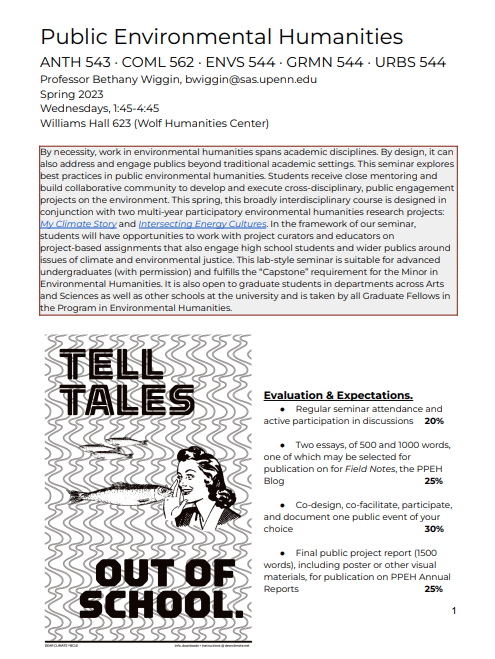
Spring 2023
ANTH 3100
Kristina Lyons
Marilyn Howarth
T, 10:15AM-1:15PM
Transdisciplinary Environmental Humanities
Meeting Time: T, 10:15AM-1:15PM
Emergent transdisciplinary fields, such as the environmental and medical humanities, reflect a growing awareness that responses to contemporary environmental dilemmas require the collaborative work of not only diverse scientists, medical practitioners, and engineers, but also more expansive publics, including artists, urban residents, rural communities, social scientists, and legal fields. This course is inspired by the need to attend to environmental challenges and their health, justice, and knowledge production implications, as inherently social concerns. This spring the class is co-taught by faculty from the School of Arts and Sciences and the School of Medicine. It addresses the challenges and possibilities of working across disciplinary boundaries, building collaborative affinities, and negotiating frictions between diverse methodologies and epistemological approaches. It contains a predominant public engaged component where students have the opportunity to learn directly from grassroots activities, scientists, legal experts, artists, and other practitioners. The seminar is suitable for early and advanced undergraduate students across Arts and Sciences as well as other schools at the university. It fulfills the "keystone" requirement for the Minor in Environmental Humanities.
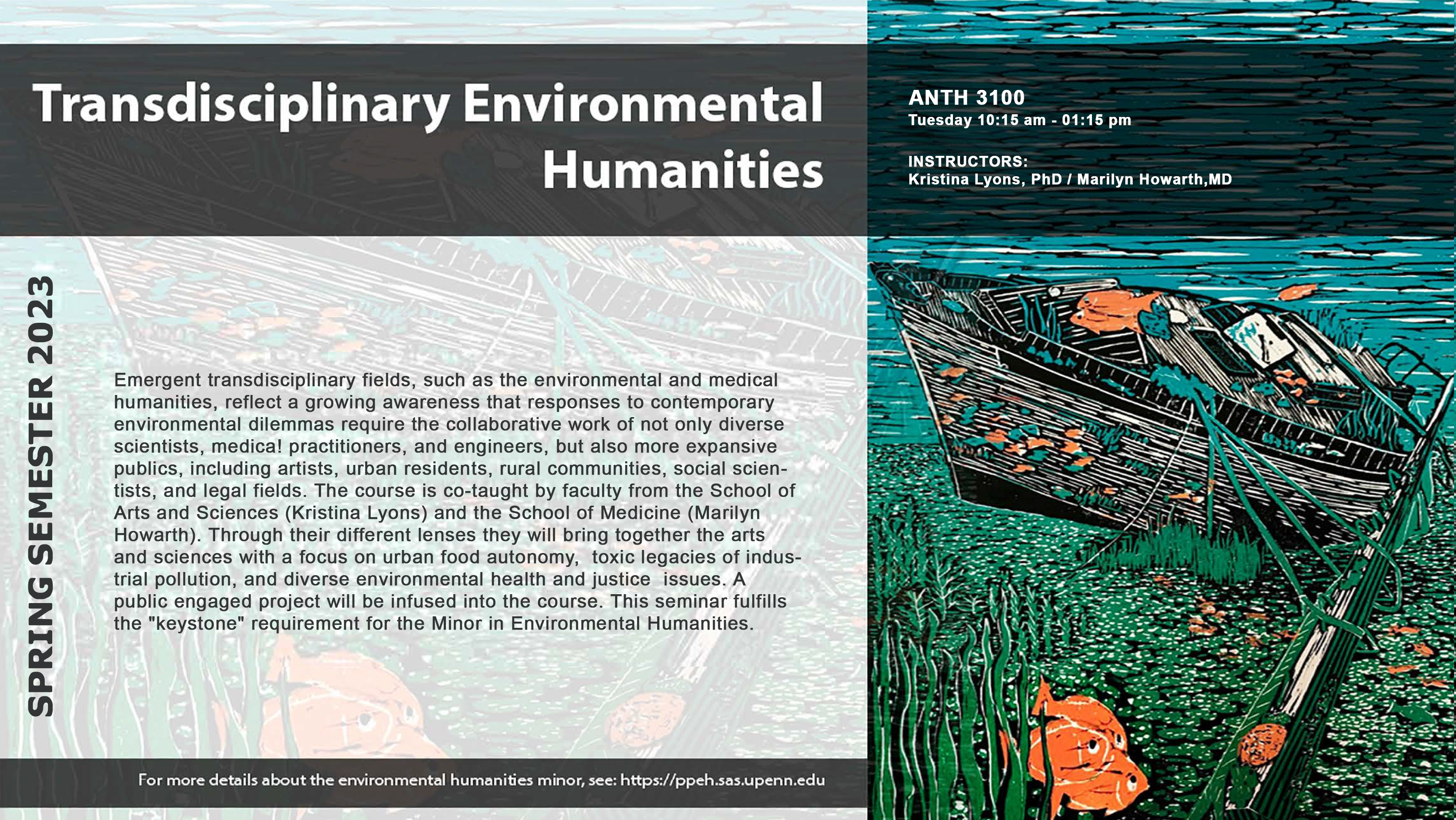
Spring 2023
ENGL 2596, CIMS 2596
Jane Robbins Mize
MW, 5:15-6:45PM
Remediating the Environment
In this interdisciplinary course, we will interrogate the term “remediation” as meaning both environmental restoration and media representation. Students will be introduced to the fields of ecocriticism and ecomedia by examining how a variety of media—from bestselling books to billboards, documentaries, and websites—have informed the cultural imagination of the environment. Students will also discover how media communications and publications about the environment can help to remediate the environment in the face of climate catastrophe. Weekly readings will include touchstone works of environmental scholarship and media including Rachel Carson’s Silent Spring and Octavia E. Butler’s Parable of the Sower. We will also examine non-print media such as NHPR’s podcast Windfall, the 2021 documentary Manzanar, Diverted: When Water Becomes Dust, and experimental work such as Lucien Castaing-Taylor and Verena Paravel’s film, Leviathan.
Lastly, course readings (and viewings and listenings and lookings) as well as assignments will emphasize publicly engaged work. Throughout the semester, students will create small- and large-scale publications that communicate with and about the environment—from zines to Tik Toks to protest banners. For their final project, students will have the opportunity to generate a creative publication in collaboration with a community organization that serves the public. We will ask questions such as: How does one effectively collaborate with a multi-faceted organization? How does one identify and reach an audience? What publics do publications serve—and which media are best suited to environmental remediation?
This course can be counted as an elective toward the Environmental Humanities minor and as fulfilling the minor's public engagement component.
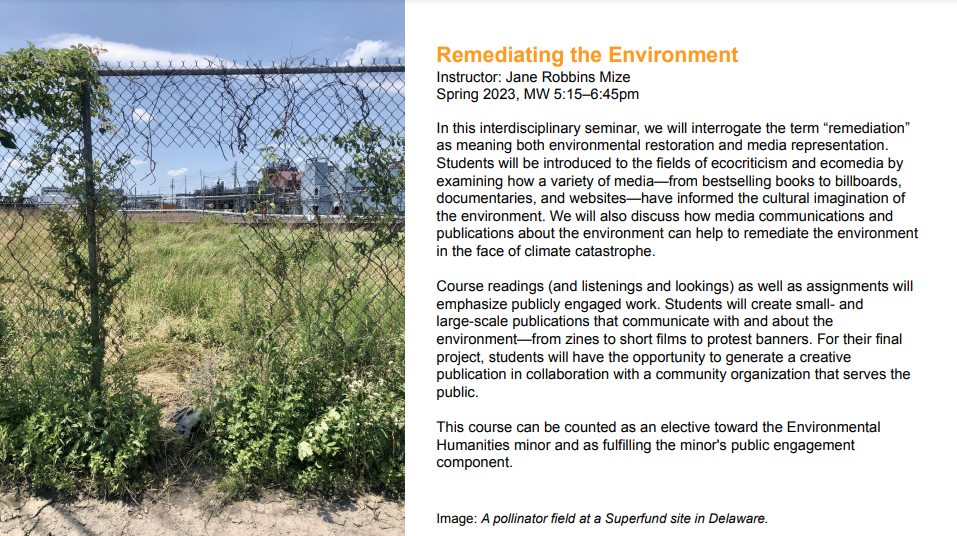
Spring 2023
LARP 7800
Sonja Dümpelmann
Tuesdays, 1:45-4:45pm
Plant(s) Matter
Plants stand at the core of landscape architecture (and of our lifeworld in general). As life-sustaining organisims, plants in their myriad forms, shapes, colors, and sizes are a fundamental component of most landscapes and built environments, regardless of how much or how little these landscapes are shaped and designed by human hands. However, as history reveals, plants have been both, landscape architecture’s strength and weakness.Today’s concerns about global warming, climate justice, as well as social and environmental justice more generally show that it is high time for landscape architecture to reconsider its vegetal origins as well as plants’ manifold values and agencies. It is necessary to overcome the presumptive weaknesses that have often been associated with a preoccupation with plants, and it is imperative to understand the politics that have guided plant use for benign and malevolent purposes. Lectures, seminar discussions, field trips, and visits to rare book collections will shed light on plants’ (especially trees) uses and roles in our landscape, environmental, and design histories to enlighten the present and suggest future possibilities of designing with and for plants.The course will be accompanied by readings in history and theory: you will contribute to a course blog and work on a research paper or mixed-media project related to the course content that will be presented in class. There are no prerequisites; this course is open to all interested students at UPenn. This course fulfills Arts & Humanities Approaches to Environmental Inquiry requirement.
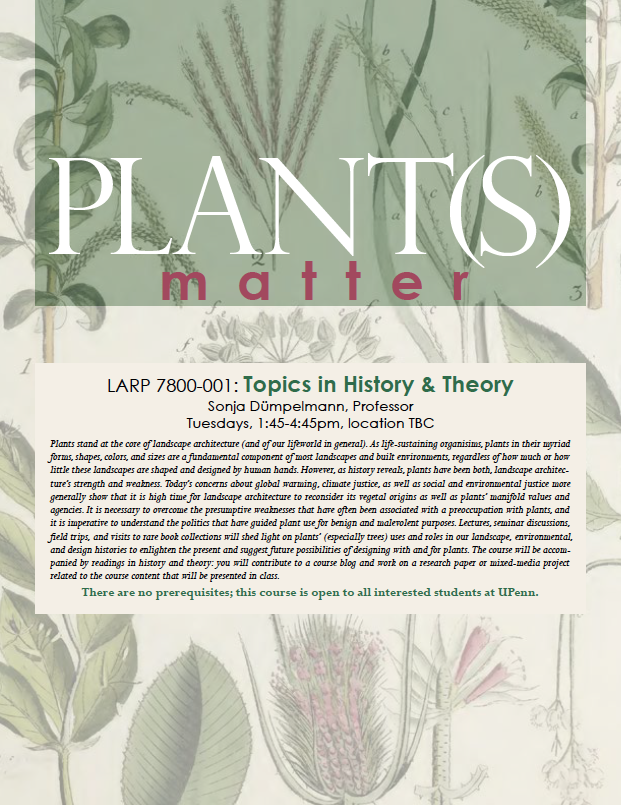
Spring 2023
ANTH 3595/5595 URBS 3595
Rachel Antoinette Cypher
Wednesdays 1:45-4:45 PM
Ecologies of Belonging
Every landscape enacts belonging and exclusion. A straight line of Locust trees, the concrete channeling of Delaware river tributaries, a Great Lawn of bermudagrass, all are ecologies that include some and exclude others, both human and nonhuman. This class will seek to trouble, expose, and explore the histories and the makings of what we will call “commonsense ecologies” – the places and landscapes in which we lead our daily lives unquestioningly. Our general aim will be to discover and create theoretical, empirical, and conceptual tools for understanding the uneven conditions of livability within the Anthropocene and the Anthropos-Not-Seen. The course will move through ecological imperialism and modernization into industrial capitalism, and finally explore ruin and resurgence. In our readings we will tack back and forth between contemporary and historical spatial analyses of landscapes and the more-than-human, combining weekly field observations with topical readings to interrogate commonsense ecologies all around us, training a critical, descriptive, and collaborative eye on industrial forms, absences, disease ecologies, Indigenous and Black histories and presences, settler colonialism, resurgence, and patchiness. Keeping a “Field” notebook will be an essential part of the class, and integral to the ways in which we will attempt to see the way theories bubble up from the empirical. As our final project, we will create a digital and publicly available “Living Landscape Archive” documenting commonsense ecologies.
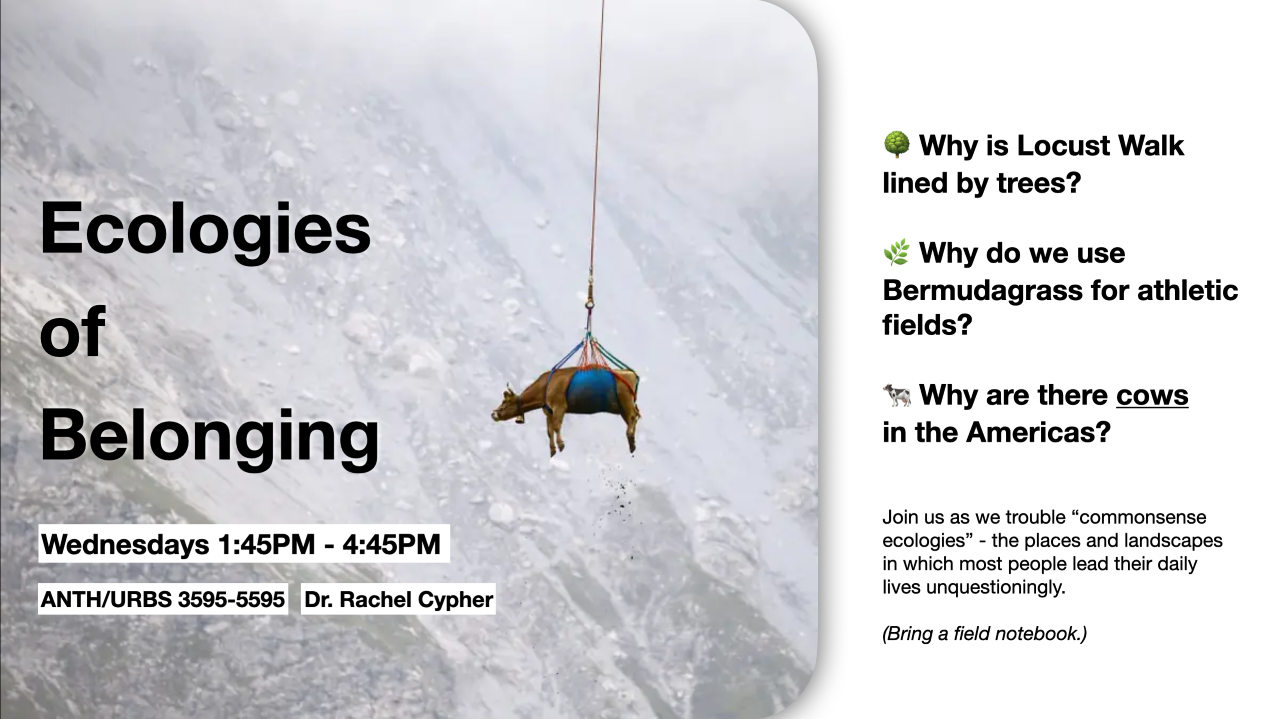
Spring 2023
DSGN 5250
Kaitlin Pomerantz
T 1:45-4:44 PM
MATTERS: Connecting Arts + Design to Materials, and Materials to Labor + Land
How does matter transform into material, and back again? What hidden labor, sites, social and ecological costs and processes go into the production of a “blank” canvas and other “raw” materials? And why-- for artists, designers, architects, preservationists, creative educators, builders, and anyone working with materials-- do these realities matter? This course connects arts and design learners to considerations, sites, and cycles around production and disposal of the defining materials of their creative fields (ex. paper, wood, glass, pigment, "the internet"), laying groundwork for creative practice rooted in social and ecological awareness, repair and care. A hybrid research seminar, field exploration, and studio investigation, the structure of this course alternates between reading/response/research, field trips and guest visitors (including a partnership affiliation with RAIR Philly), and time for responsive “making” and material experimentation/synthesis. In this course, students will collaboratively define key terms and concerns around material sustainability, discard studies, land and labor relations vis-a-vis creative work. Students will experience local sites of material extraction, production and disposal (through approx 5 field trips taking place during class time). Students will formulate individual or group questions around a specific material, leading to a final independent project, and class exhibition. This course will engage students in forming a material ethics to guide future creative work.
